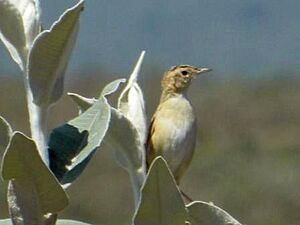Black-backed cisticola facts for kids
Quick facts for kids Black-backed cisticola |
|
|---|---|
 |
|
| Female at Gilgil, Kenya | |
| Conservation status | |
| Scientific classification |
The black-backed cisticola is a small, active bird. It is also sometimes called the black-necked cisticola. This bird belongs to a group of birds called passerines. These are often known as "perching birds." The black-backed cisticola is part of the Cisticolidae family.
You can find this bird in many countries across Africa. These include Burkina Faso, Chad, Republic of the Congo, and Democratic Republic of the Congo. It also lives in Ivory Coast, Eritrea, Ethiopia, and Ghana. Other homes are Guinea, Guinea-Bissau, Kenya, and Mali. You might also see it in Nigeria, Senegal, Sierra Leone, and South Sudan. Finally, it lives in Tanzania, Togo, and Uganda.
This bird likes to live in certain places. Its natural habitats are grassy areas. It prefers warm, dry grasslands. It also likes grasslands that get wet or flooded during certain seasons.
What is a Black-backed Cisticola?
The black-backed cisticola is a type of songbird. It is known for its unique calls. These birds are usually small. They often blend into their grassy surroundings.
They are part of the Cisticola genus. This group includes many similar small birds. They are often hard to tell apart.
Where Do Black-backed Cisticolas Live?
These birds live in a wide area of Africa. They are found across central and western parts of the continent. They prefer open, grassy areas.
Their homes can be dry plains or wetlands. They adapt well to different types of grasslands. This helps them find food and build nests.
Naming the Black-backed Cisticola
The black-backed cisticola was first described in 1869. A German explorer and bird expert named Theodor von Heuglin did this. He found a specimen near the Bahr el Ghazal River. This river is in South Sudan.
He gave it the scientific name Drymoeca eximia. The word eximius comes from Latin. It means "select" or "distinguished." This suggests he thought the bird was special. Today, it is placed in the Cisticola group. This group was named by another German naturalist, Johann Jakob Kaup, in 1829.


